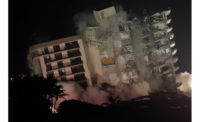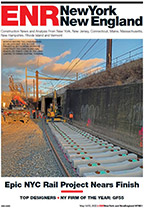Designers Call for Coordinated Effort To Improve New York City Region's Flood Resistance
A huge problem is that some 80,000 buildings in FEMA’s new flood zones don’t meet FEMA requirements for National Flood Insurance. To qualify, thousands of homeowners will have to raise their buildings. Elevating a house could cost 50% to 100% of its value, said Ginsberg, who added that the fix is unaffordable for most homeowners.
For housing, “efforts should be made to develop more affordable flood-proofing options [than raising structures], such as active barriers,” says the report.
In addition, FEMA gave no thought to the accessibility rules under the Americans With Disabilities Act of 1990, said Ginsberg. “If you raise a house five feet, you would need a total 70-foot-long ramp with landings to meet the law,” he said. To make matters worse, New York City’s building code has banned lifts for people with disabilities.
The AIANY initiative is recommending that New York City permit handicapped lifts in flood zones and that wet flood-proofed buildings have an emergency exit at the first floor above the flood elevation. In addition, as an alternative to flood-proofing individual buildings, the code should allow block-wide or neighborhood-wide flood-proofing.
Though the report offers dozens of design, zoning, code and policy recommendations, funding sources for the proposed initiatives are not addressed, except broadly. “Funding will be an ongoing issue,” said landscape architect Denisha Williams, a principal of Being Here Landscape Architecture & Environmental Design and co-chairwoman of the initiative’s waterfront working group.
"We have [as a community] a limited pot of money and lots of ideas, with a very limited discussion of how much money we have and what we want to do,” added Ginsberg.
As far as research and development is concerned, the report says, “The work of the Waterfront Lab could be an important contribution to how the city assesses new proposals that have never been put in place here—efforts that could advance flexible and sustainable waterfront planning and design for the future—based on best practices around the world.”
The lab could study proposals for sea walls and wave walls, natural and armored dunes, permeable waterfront parks in floodplains and model waterfront districts with distributed infrastructure, among other systems.
“We see the projects as being funded from both conventional and innovative funding sources amalgamated from the public sector as well as public-private partnerships backed by private and philanthropic resources,” said Williams.
As food for thought, the document offers various examples of flood control. Among these examples is Tokyo’s cavernous, underground flood-diversion facility, called G-Cans Project or the Metropolitan Area Outer Underground Discharge Channel. The world’s largest underground floodwater-diversion facility, it is designed to fill with water during typhoon season and heavy rains.
Another flood-mitigation system is an underground parking garage at Museum Park in Rotterdam that accommodates 1,500 cars or, when necessary, can contain 10 million liters of water.
For resiliency, “a full-spectrum response is necessary,” said architect Illya Azaroff, founding partner of +LAB, Brooklyn, N.Y., and co-chairwoman of the AIANY design for risk and reconstruction committee.





